
The Battle of Solferino on 24 June 1859 resulted in the victory of the allied French army under Napoleon III and the Piedmont-Sardinian army under Victor Emmanuel II against the Austrian army under Emperor Franz Joseph I. It was the last major battle in world history where all the armies were under the personal command of their monarchs. Perhaps 300,000 soldiers fought in the important battle, the largest since the Battle of Leipzig in 1813. There were about 130,000 Austrian troops and a combined total of 140,000 French and allied Piedmontese troops. After the battle, the Austrian emperor refrained from further direct command of the army.

The 1848 Revolutions in the Italian states, part of the wider Revolutions of 1848 in Europe, were organized revolts in the states of the Italian peninsula and Sicily, led by intellectuals and agitators who desired a liberal government. As Italian nationalists they sought to eliminate reactionary Austrian control. During this time, Italy was not a unified country, and was divided into many states, which, in Northern Italy, were ruled directly or indirectly by the Austrian Empire. A desire to be independent from foreign rule, and the conservative leadership of the Austrians, led Italian revolutionaries to stage revolution in order to drive out the Austrians. The revolution was led by the state of the Kingdom of Sardinia. Some uprisings in the Kingdom of Lombardy–Venetia, particularly in Milan, forced the Austrian General Radetzky to retreat to the Quadrilateral fortresses.

Johann Josef Wenzel Anton Franz Karl, Graf Radetzky von Radetz was a Czech nobleman and Austrian field marshal. He served as chief of the general staff in the Habsburg monarchy during the later period of the Napoleonic Wars and proved instrumental in the allied victory as one of the primary architects of the Trachenburg Plan and the Leipzig Campaign. Afterwards, he embarked on military reforms of the Austrian army. His reputation was one of discipline and fairness; he was revered by his troops among whom he was known as Vater ('Father') Radetzky. He is best known for the victories at the Battles of Custoza and Novara during the First Italian War of Independence. Johann Strauss I's Radetzky March was commissioned to commemorate Radetzky's victories at the Battle of Custoza.

The Kingdom of Lombardy–Venetia, commonly called the "Lombardo-Venetian Kingdom", was a constituent land of the Austrian Empire from 1815 to 1866. It was created in 1815 by resolution of the Congress of Vienna in recognition of the Austrian House of Habsburg-Lorraine's rights to the former Duchy of Milan and the former Republic of Venice after the Napoleonic Kingdom of Italy, proclaimed in 1805, had collapsed.
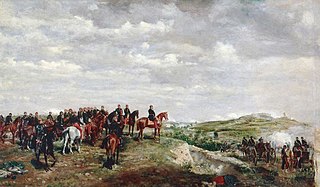
The Second Italian War of Independence, also called the Sardinian War, the Austro-Sardinian War, the Franco-Austrian War, or the Italian War of 1859, was fought by the Second French Empire and the Kingdom of Sardinia against the Austrian Empire in 1859 and played a crucial part in the process of Italian Unification.
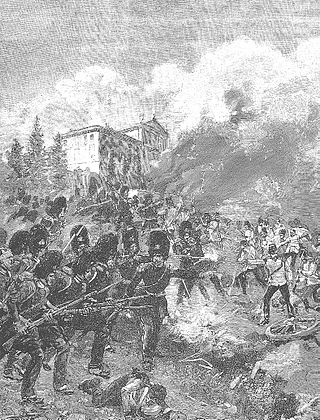
The First Battle of Custoza was fought on July 24 and 25, 1848, during the First Italian War of Independence between the armies of the Austrian Empire, commanded by Field Marshal Radetzky, and the Kingdom of Sardinia, led by King Charles Albert of Piedmont-Sardinia.
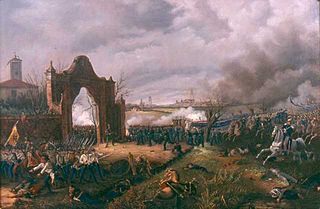
The First Italian War of Independence, part of the Italian Unification (Risorgimento), was fought by the Kingdom of Sardinia (1720–1861) (Piedmont) and Italian volunteers against the Austrian Empire and other conservative states from 23 March 1848 to 22 August 1849 in the Italian Peninsula.

The Battle of Goito was fought between the Piedmontese and the Austrian army on 30 May 1848, in the course of the First Italian War of Independence. The Piedmontese army won the battle, as the Austrians were unable to break through to relieve the siege of Peschiera and prevent its surrender which happened on the day before the battle.

The Skirmish of Pastrengo was fought between the Piedmontese and Austrian army on 30 April 1848, in the course of the First Italian War of Independence.
The Battle of San Pietro, also known as the Battle of Crocetta or the Battle of Parma was a battle fought on 29 June 1734 between troops of France and Sardinia on one side, and Habsburg Austrian troops on the other, as part of the War of Polish Succession, between the village of La Crocetta and the city of Parma, then in the Duchy of Parma. Austrian troops assaulted an entrenched Franco-Sardinian position, and were ultimately repulsed, due in part to the death of their commander, Florimund Mercy, and the wounding of his second in command, Frederick of Württemberg. Both sides suffered significant casualties in the battle, which lasted for most of the day.

The Five Days of Milan was an insurrection and a major event in the Revolutionary Year of 1848 that started the First Italian War of Independence. On 18 March, a rebellion arose in the city of Milan which in five days of street fighting drove Marshal Radetzky and his Austrian soldiers from the city.

The Republic of San Marco or the Venetian Republic was an Italian revolutionary state which existed for 17 months in 1848–1849. Based on the Venetian Lagoon, it extended into most of Venetia, or the Terraferma territory of the Republic of Venice, suppressed 51 years earlier in the French Revolutionary Wars. After declaring independence from the Habsburg Austrian Empire, the republic later joined the Kingdom of Sardinia in an attempt, led by the latter, to unite northern Italy against foreign domination. But the First Italian War of Independence ended in the defeat of Sardinia, and Austrian forces reconquered the Republic of San Marco on 28 August 1849 following a long siege.

The Belfiore martyrs were a group of pro-independence fighters condemned to death by hanging between 1852 and 1853 during the Italian Risorgimento. They included Tito Speri and the priest Enrico Tazzoli and are named after the site where the sentence was carried out, in the valley of Belfiore at the south entrance to Mantua. The hanging was the first in a long series of death sentences imposed by Josef Radetzky, governor general of Lombardy–Venetia. As a whole these sentences marked the culmination of Austrian repression after the First Italian War of Independence and marked the failure of all re-pacification policies.

Count Ferenc Gyulay de Marosnémethi et Nádaska, also known as Ferencz Gyulai, Ferencz Gyulaj, or Franz Gyulai, was a Hungarian nobleman who served as Austrian Governor of Lombardy-Venetia and commanded the losing Austrian army at the Battle of Magenta.

Eusebio Bava was an Italian general who fought in the First Italian War of Independence.

Philipp Franz Emerich Karl von Stadion und Thannhausen was an Austrian feldmarschall-leutnant and Landkomtur of the Teutonic Order in Austria.
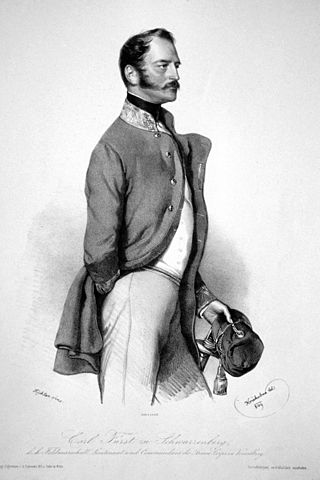
Karl II Prince of Schwarzenberg was an Imperial Austrian noble and Feldzeugmeister, who fought in the First Italian War of Independence. He was Governor of Transylvania between 1851 and 1858.
The Imperial Austrian Army formed the land forces of the Austrian Empire. It arose from the remains of the Imperial Army of the Holy Roman Emperor after its dissolution and in 1867 was reformed into the Common Army of Austria-Hungary and the Imperial-Royal Landwehr after the Austro-Hungarian Compromise of 1867. In addition to the army, there was also the Austrian Navy. The army took part in the Napoleonic Wars until 1815, the First Italian War of Independence, the Hungarian Revolution of 1848, the Second Italian War of Independence, the Second Schleswig War, the Third Italian War of Independence and the Austro-Prussian War. Notable generals were Josef Radetzky, Karl Philipp of Schwarzenberg, Archduke Charles, Duke of Teschen, Frederick Bianchi and Julius von Haynau.
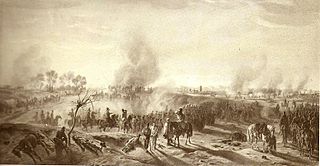
The Battle of Mortara was a battle between 19,000 Austrian and 26,000 Italian forces on 21 March 1849.

The defensive system of Verona is a military, logistical and infrastructural complex consisting of city walls, bastions, forts, entrenched camps, warehouses and barracks, built between 1814 and 1866 during Habsburg rule, which made the Venetian city, the pivot of the so-called "Quadrilatero," one of the strong points of the Empire's strategic system. Thus Austrian Verona became an army stronghold, that is, a center that could supply the entire imperial garrison present in the Kingdom of Lombardy-Venetia, consisting of approximately 100,000 soldiers.


















